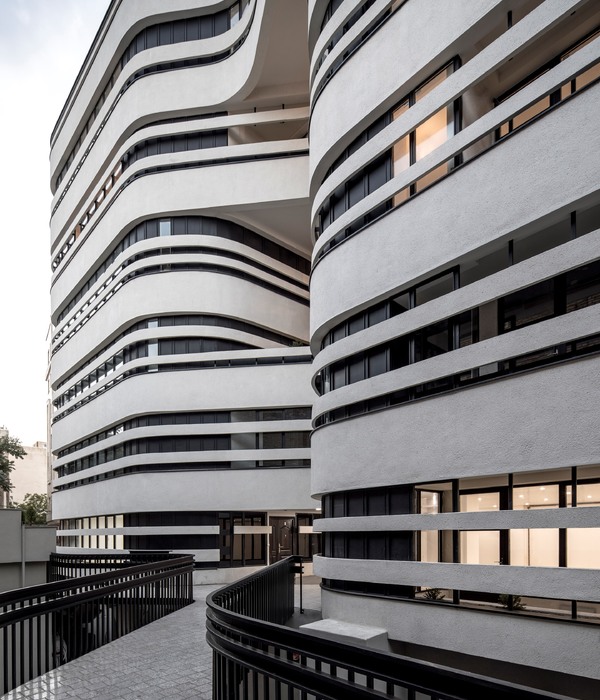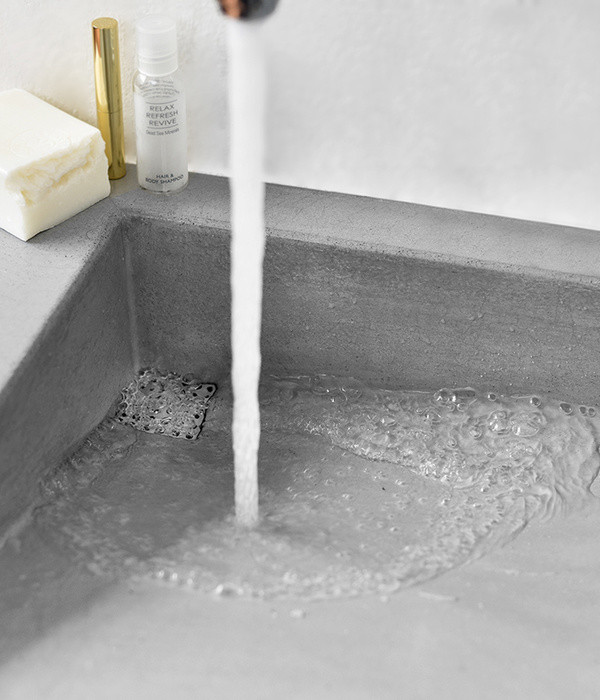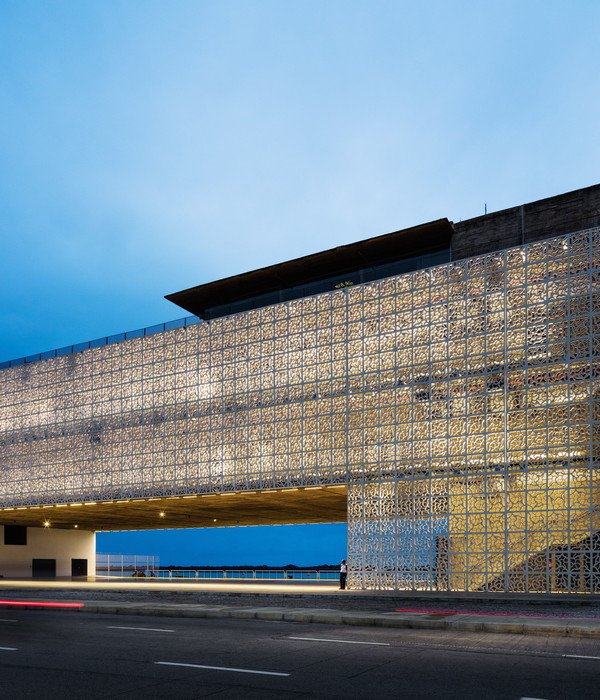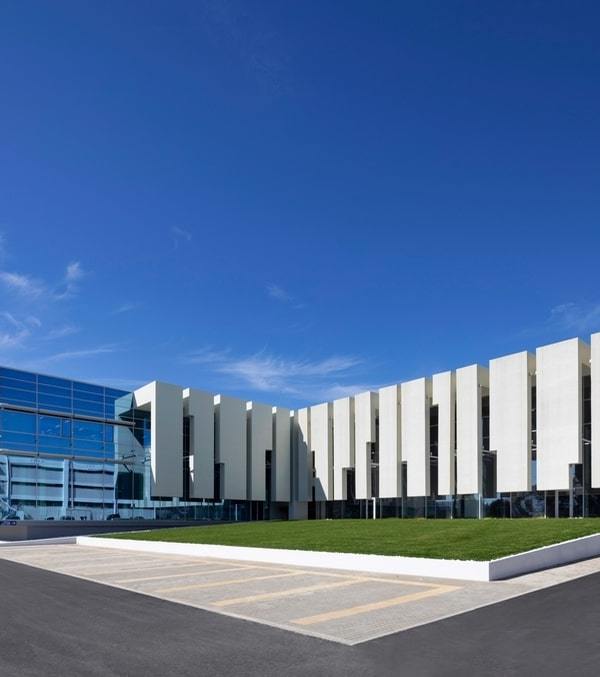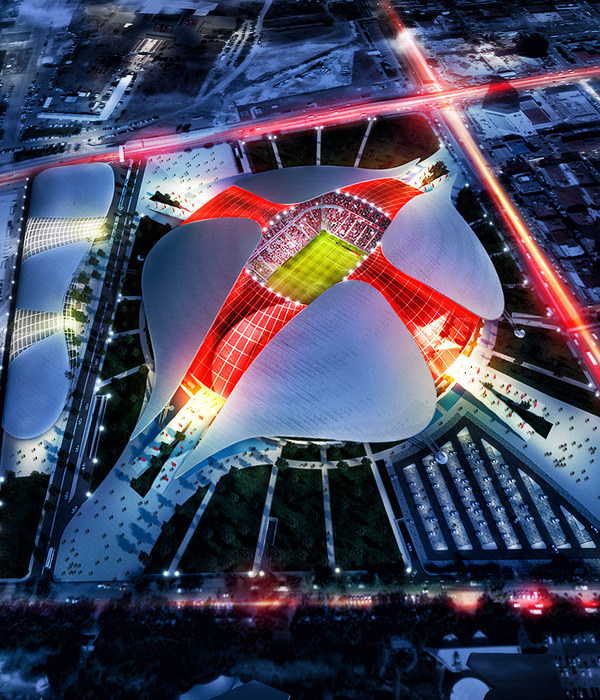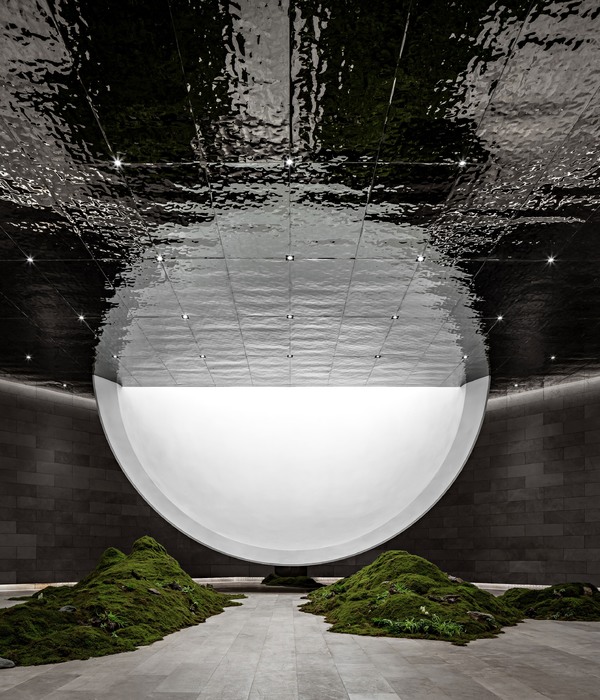- 项目名称:天府文创城规划展示厅
- 设计方:AND Studio安棣建筑事务所
- 主创:王宁
- 设计团队:李沁怡,Tien,马雨彤,隋欣
- 项目地址:成都
- 建筑面积:1189.6 ㎡
- 造价:2000万
- 合作单位:西北综合勘察设计研究院
- 结构:丁剑豪,蒋万刚
- 照明:谢月
- 施工:西北综合勘察设计研究院
- 摄影版权:存在建筑(摄影+摄像),天府文创城
- 主要材料:竹钢,钢,铝板,玻璃,水磨石,清水混凝土
- 类型:建筑设计,室内设计
沿着成都市中轴线上的交通大动脉天府大道一路向南,就是被湿地环绕、林盘点缀的天府新区。作为“一带一路”建设和长江经济带发展的重要节点,天府新区的规划与建设一直将生态价值放在重要位置。
Surrounded by wetlands and forests, the Tianfu New Area is located along south of the Tianfu Avenue, the central axis of Chengdu. As an important node in the construction of “the Belt and Road Initiatives” and the development of the Yangtze River Economic Belt, the planning and construction of the Tianfu New Area has always placed a high priority on ecological value.
▼建筑外观,Exterior view
▼鸟瞰,Aerial view
雁栖湿地位于天府文创城中心位置,也是天府新区建设“公园城市”理念的窗口。田园、浅丘、林地、河道在这片土地静静生长。“雁之羽”天府文创城规划展示厅轻巧坐落在湿地山头之上,宛若在原生自然环境中生长出来一般,将成为天府新区的鲜明标识。
The Yanqi Wetland is in the center of the Tianfu Cultural and Creative City, as a showcase for the “Park City” concept, with fields, shallow hills, woodlands and rivers around. Chengdu Tianfu City Planning Hall is lighted perched on a wetland hill, blending in with nature. It will become the distinctive identity of Tianfu New Area.
▼场地位置,Location
雁栖于山林
Design Concept of “wild goose perched on the hill”
建筑选址于雁栖湿地的高点,概念取义大雁南飞栖于山头。纤细的屋面檐口斜向上生长、向外突出,结合弯折的屋顶造型,仿佛在山林绿意之中“正展开双翅的大雁”,寄语天府数字文创城起势腾飞,更传达出“自然生长之城”和“诗意栖居之城”的公园城市表达新范式。
The design concept is derived from the wild goose flying south and perched on the hill. The slender roof gable grows upwards and outwards, combining with the curved roof shape are in response to the concept.
▼概念图,Concept
主创建筑师王宁说:“如果是一个通透的玻璃盒子,从远处看是没有存在感的,高度的玻璃反光在农田里也非常不和谐。所以我们一开始就想创造一个‘虚’的形式,就像鸟的羽毛,可以呼吸,阳光和视线都能穿越它。”
Lead architect Wang Ning shared his idea “If the architecture is just a glass box, it would have no presence from a distance, and the highly reflective glass would be very incongruous in a farmyard. Thus, we wanted to create that ‘imaginary’ body from the outset, like a bird’s feathers that can breathe and through which sunlight and sight can cross it.”
▼建筑远景,Distant view
▼鸟瞰,Aerial view
建筑底层采取架空柱廊的形式,屋檐向外挑出,可以在漫步其下。远观建筑主体仿佛“立”于高处,深远的挑檐“展翅欲飞”,近看建筑主体退隐山林。从功能上来讲,它既是城市发展的展示馆,也是这片城市新区发展的见证者。
The ground floor is elevated and has colonnades under the eaves that project outwards to allow for a stroll underneath. The building appears to be standing on high space from distance while up close it appears to be hidden away in the mountains. It is a showcase for the city’s development as well as a witness to the development of this new area.
▼从田间看建筑,View from the field
▼深远的挑檐“展翅欲飞”, The building appears to be hidden away in the mountains
与自然共生
In harmony with nature
建筑立面采用大面积的隐框玻璃肋幕墙,将室外雁栖田园湿地“借景入馆”,同时将公园场景延伸至室内,消解建筑与自然的边界,营造一种与自然共生的意境。
The building façade adopts a large area of hidden-frame glass ribbed curtain wall. This extends the outdoor pleasant view into the interior, dissolving the boundary and creating a sense of symbiosis between architecture and nature.
▼透过玻璃幕墙望向室外景色,View through the curtain wall
室内的中庭采用了天井的形式,“引光入馆”,将自然光线“借”入室内,配合一层室内竹林景观的设计,“借景入室”,让人身在建筑中也可以感受到周围与之共存的自然环境。
The interior atrium uses a patio to bring in natural light and the interior bamboo landscape on the ground floor allows people to feel surrounded by nature even within the building.
▼室内空间,Interior view
▼中庭,Atrium
从二层的观景平台远眺,大片的绿植、湖泊尽收眼底。屋面的铝板材质与特色的竹钢材料结合,在光影之下营造出独特的韵味。
The distant view from the second floor platform reveals a large expanse of greenery and the lake. The aluminum roof panels combined with the characteristic wooden bamboo structure creates a unique rhythm with light and shadow.
▼二层观景平台,Viewing platform
可部分上人的屋顶是视线极佳之处,一览天府数字文创城整个核心区的规划建设全景。而在天府大道上回望,在掩映的湿地景观中是自由而轻盈的曲面屋顶,仿佛栖息的雁羽。
The partially accessible rooftop is a great place to get a panoramic view of the entire core area of the Tianfu Cultural and Creative City. Meanwhile, looking back over the Tianfu Avenue, the curved roof is set against the sheltered wetland landscape, like the feather of the wild goose.
▼施工中从屋顶向外看,Construction phase
▼挑檐下空间,The covered space
▼挑檐,Eave
在地性表达
Localization expression of the material
屋顶的吊顶装饰从低碳环保和可持续建造的角度出发,依托川蜀的竹文化,选定竹这种传统材料,经过新型工艺形成竹钢材质。通过单元模数化的竹钢十字构件相互之间榫卯和栓接,形成层层叠叠、模糊的木构空间。
The ceiling decoration of the roof is considered from the aspect of low carbon and sustainable construction. Relying on the bamboo culture of Sichuan, the traditional material of bamboo has been selected to be formed into wooden bamboo through a new process. The modular wooden bamboo cross members are mortised and pinned to each other to form multiple layers of ambiguous timber frame space.
▼铝板屋顶与竹钢构件,Aluminium roof and bamboo-steel structure
▼竹钢近景,bamboo-steel
设计师尝试以现代的建筑语言和建造技术,去转译并延续中国传统建筑的质朴自然。既要保证在近景处充满细节,也要在天府大道的主轴线处完美的展现出来光影和轻盈感。同时还要考虑建造的经济性。在不断对结构的连接方式和整体建筑美学效果进行深化后,共采用20根立柱和约30000个挂件以交叉咬合链接的方式完成最终效果。
The architects attempted to use modern architectural language and construction techniques to translate and perpetuate the rustic elegance of traditional Chinese architecture. It is important to ensure that the architecture is full of detail being viewed from close up, as well as perfectly displaying its lightness and lightness at the main axis of Tianfu Avenue. The economy of construction is also taken into account. After continuous refinement of the structural connections and the overall architectural aesthetics, a total of 20 columns and approximately 30,000 pendants are used to complete the final effect by means of cross-over bite links.
▼链接方式,Link method
▼链接结构分析图,Diagram
远看似雁羽般轻盈消隐,近看又不失羽翼的细节。设计团队在川西平原上,探索了一种轻建造的新模式。王宁说:“我觉得特别符合成都人的生活:轻松,在地,丰富多彩又非一成不变。”
The architecture fades lightly into the environment from a distance, while up close it is richly detailed, like the feathers of a wild goose. The design team has explored a new pattern of light construction on the plains of western Sichuan. Ning Wang says:” I think it fits particularly well with the life of Chengdu people: relaxed, local, colourful but not static.”
▼夕阳鸟瞰,Aerial view in the evening
▼夜景,Night view
▼总平面图,Masterplan
▼一层平面,Plan 1F
▼二层平面,Plan 2F
▼立面图1,Elevation 1
▼剖面图,Section
▼轴测图,Axonometric view
项目名称:天府文创城规划展示厅
设计方:AND Studio安棣建筑事务所
项目设计 & 完成年份:2020.08-2022.05
主创:王宁
设计团队:李沁怡 ,Tien,马雨彤,隋欣
项目地址:成都
建筑面积:1189.6 ㎡
造价:2000万
合作单位:西北综合勘察设计研究院
结构:丁剑豪,蒋万刚
照明:谢月
施工:西北综合勘察设计研究院
摄影版权:存在建筑(摄影+摄像)、天府文创城
主要材料:竹钢,钢,铝板,玻璃,水磨石,清水混凝土
类型:建筑设计,室内设计
Project Name: Chengdu Tianfu City Planning Hall
Design: AND Studio
Design Stage (Start-End): 2020.08-2021.06
Construction Stage (Start-End): 2020.12-2022.05
Lead Architect: Ning Wang
Design Team: Qinyi Li, Tien, Yutong Ma, Xin Sui
Location: Chengdu
Building Area (sqm): 1189.6
Cost: 20 million
Consultant: CSCEC AECOM Consultants Co., Ltd
M&E Consultant: Xin Luo
Lighting Consultant: Yue Xie
Contractor: CSCEC AECOM Consultants Co., Ltd
Main Material: Wooden Bamboo, Steel, Aluminium Panels, Glass, Terrazzo, Fair-faced Concrete
Photopraphy: Arch-Exist Photography
{{item.text_origin}}

